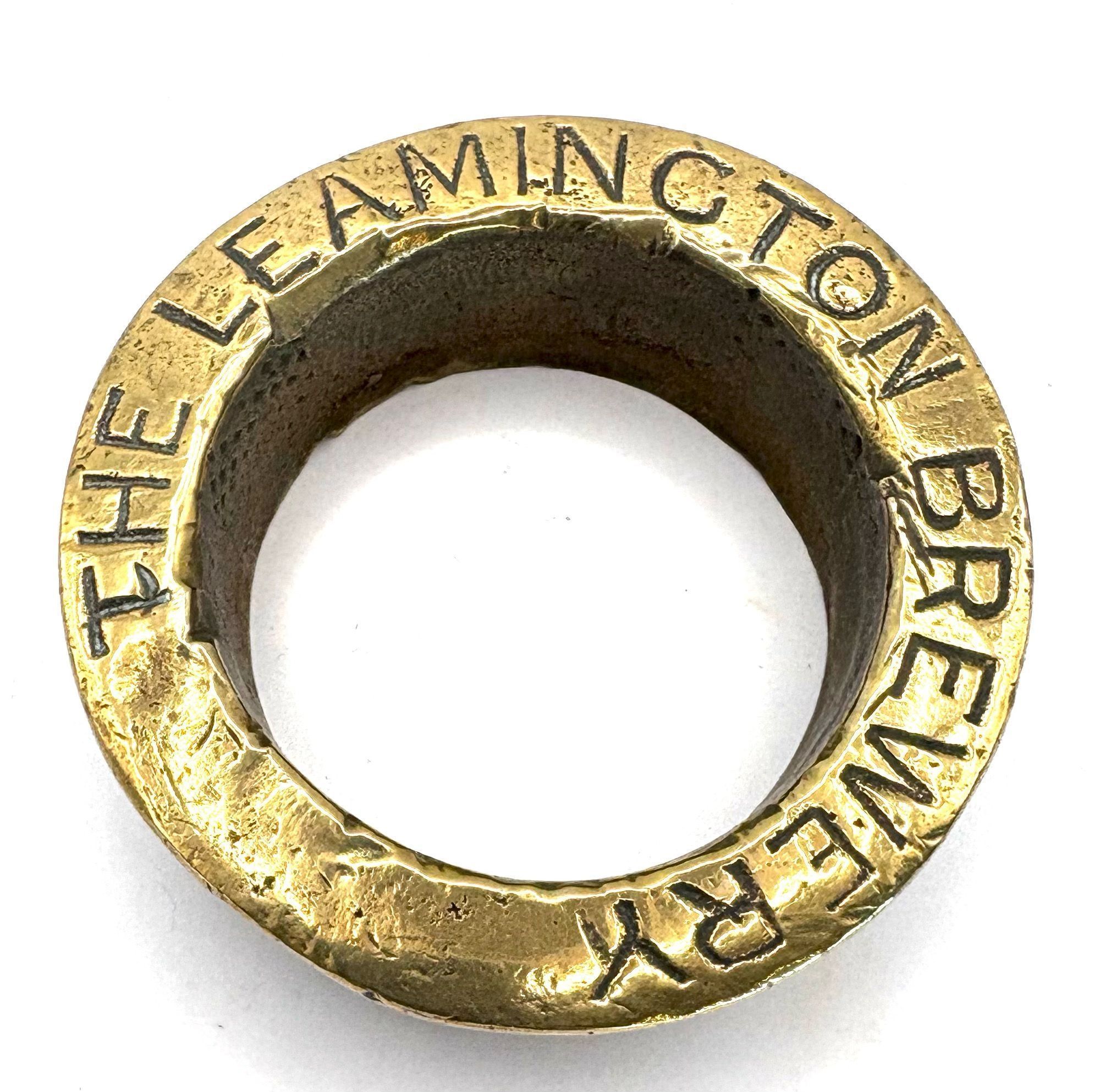The Leamington Brewery Brass collar
Name/Title
The Leamington Brewery Brass collarEntry/Object ID
2025.1.409Description
The Leamington Brewery Beer barrel brass collarContext
The Leamington Brewery started as a small business attached to the Golden Lion public house (what was later to become a branch of RBS) in Regent Street, in the centre of town. In August 1839, a high end silk merchant from London, Stephen Lewis and some local businessmen acquired a site of about 1,030 square yards in Lillington Avenue. The first brewery on this new site was constructed to a design by John Tone of Stoneleigh in 1840 and brewing commenced in 1841, it is shown on an 1842 map of Leamington as “Lewis’ Brewery”. Additional adjacent land was subsequently purchased in 1853 with the intention of improving access onto the site, along what is now the WDC playing field; however no new entrance road was ever built. The brewery buildings as we know them today were designed by the architect Robert Davison and built in 1861. Davison had set up his company in the late 1840’s and this was his first commission. He subsequently went on to develop the company, building much larger structures in London and Burton on Trent and has been called the father of brewery architecture. During the years that followed the partners varied, but an important influence was John Haddon, a well known Warwick solicitor who eventually took over the company. Upon Lewis’ death in 1871, Haddon was joined by Lewis’ son, Arthur and William Wells Ridley and the brewery became known as Lewis and Ridley. This group of partners finally sold the brewery on 5th June 1885 together with 34 public houses that they owned in various parts of Warwickshire. The purchaser was initially Morton Peto Lucas, who had become involved in 1880, as sole proprietor. He was later joined by his brother, Frederick Murray Lucas, Arthur Herbert Blackwell, a famous cricketer and Herbert Robert Arkwright. The brewery initially became known as Lucas and Company and then Lucas, Blackwell and Arkwright, as the new partners came on board. By 1897 though, it appears the company had reverted to Lucas & Co following the deaths of FM Lucas and Blackwell and the retirement of Arkwright. During this time and whilst under the management of Mr A. E. Wyllie, who was also head brewer, the buildings were considerably altered and the main brewery was re-erected in 1896. This allowed the brewery to double its capacity from “40 to 80 quarter plant brewery” and employed nearly a hundred people. This last owner continued trading until the brewery was acquired by Ansells of Birmingham in November 1928, who in turn sold the site and the buildings on the 6th July 1934 to the Borough of Leamington Spa, after removing all of the equipment. The sale was conditional on it not being used as a brewery, although Ansells continued to lease some of the buildings from their new owner for a period of 21 years. Lucas & Co went into liquidation in 1966 Lucas and Company were certainly one of the biggest of Warwickshires breweries, but this was no protection from the takeovers of Ansells and Mitchells and Butlers, who in the ‘20’s and ‘30’s were engaged in a major battle to secure the Midlands brewing trade. After the Ansells’ lease expired, the buildings were used as a highways depot and store by the local authority. The original Linden Arches from the Pump Room gardens were found stored here, when taken over by the developer in the mid ‘80s. During the early seventies, it was also used as the archives for the local newspaper group. In 1974, the site passed into the hands of the Warwick District Council, who some years later sold the buildings for conversion into houses and apartments, with further new properties being built on other parts of the site. This development opened in 1989 and is now known as ‘The Maltings’. There are still two of the original buildings and a number of features of the 1861 brewery remaining. The 266’ long main malt house and beer store building, which included two kilns has been retained, this is now numbers 5-31, The Maltings. The buildings two former sack hoists still being visible but now are bedrooms. Also retained is the brew masters house and office building at the front of the site, which is now numbers 1 & 3, The Maltings, as well as the front railings and gates. Unfortunately, the main brew house, which was a four storey building with a clock tower, was deemed in too bad a state of disrepair by the developer and was demolished; this was where Finings Court now stands. On what is now the central green, stood three tun rooms and the stables for the dray horses. The land on which now stands numbers 2-8, The Maltings, Bell and Barley Courts, was in 1885 open fields, but by 1934 had been taken over by various outbuildings, these have all subsequently been demolished. Source: Maltingshistory.comCategory
Breweries and Brewing

